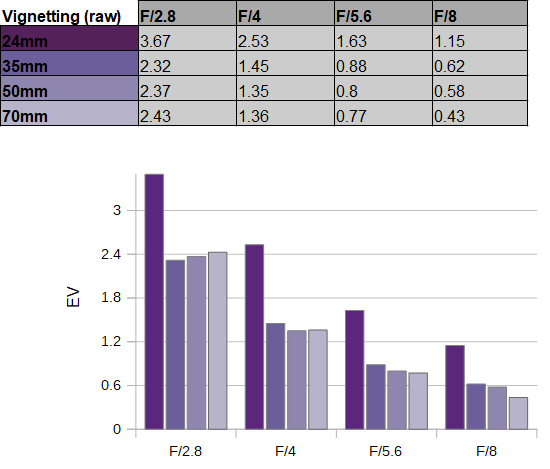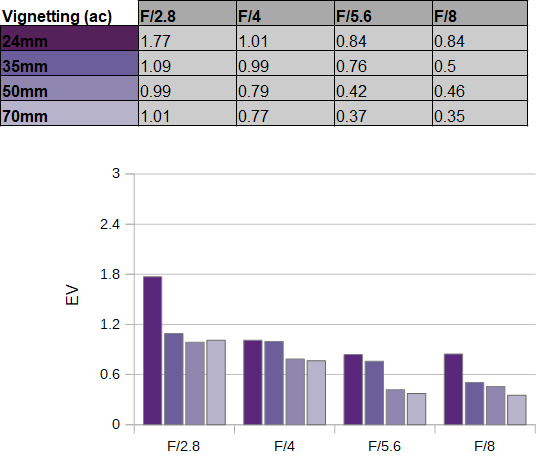|
Sigma 24-70mm f/2.8 DG DN ART - Review / Test Report - Analysis |
|
Lens Reviews -
Sony Alpha (Full Format)
|
|
Page 2 of 3

Distortion
The Sigma 24-70mm f/2.8 DG DN ART produces some fairly strong image distortions in RAW files. Unsurprisingly, the issue is most pronounced at the extreme ends of the zoom range with a barrel distortion of 3.8% at 24mm and a pincushion distortion of 1.5% at 70mm. The two "forces" even out in the lower middle range.
Of course, this is all mostly irrelevant (other than a slight decrease in corner resolution) with activated image auto-correction as you can see below.
Vignetting
The RAW vignetting characteristic is somewhat worse than expected peaking in a hefty light falloff of 3.6EV (f-stops) at 24mm f/2.8. The issue is just slightly reduced at other focal lengths at f/2.8. Stopping down improves the situation in the 35-70mm range but the vignetting remains heavy at 24mm f/4. The aspect is better at f/5.6 although 24mm remains the weakest spot.

Once again, if you prefer to activate image auto-correction, the algorithm reduces the fall-off substantially although vignetting remains visible at 24mm f/2.8 at least.

MTF (resolution)
The resolution charts show one of the typical issues that most fast standard zoom lenses still face - consistency. The broader center performance is generally great across the zoom range and especially at wider settings where it certainly exceeds the capabilities of the 42mp sensor used for testing. However, the same can't be said about the outer image field. The corners are generally quite soft at f/2.8 although the borders are quite good here at least. Stopping down results in a gradual increase in quality with peak quality reached between f/5.6 and f/8. The borders are, overall, very good here and the corners are good to very good.
The field curvature is generally low. The centering quality of the tested sample was very good.
Please note that the MTF results are not directly comparable across the different systems!
Below is a simplified summary of the formal findings. The chart shows line widths per picture height (LW/PH) which can be taken as a measure for sharpness.
If you want to know more about the MTF50 figures you may check out the corresponding Imatest Explanations

Chromatic Aberrations (CAs)
Lateral CAs (color shadows in the outer image field) are generally low with an average pixel width around 1px at the image borders. Once again, image auto-correction can basically eliminate this issue and should be kept active due to its lossless nature.

Bokeh
We mentioned it before - a 24-70mm f/2.8 doesn't really qualify as TERRIBLY fast. Many cheaper prime lenses can easily beat this at lower costs. However, while such lenses may not substitute prime lenses, you can still achieve a fairly decent amount of object separation so let's check the quality of the bokeh (out-of-focus rendition).
Out-of-focus highlights don't have a perfectly clean inner zone and there's a bit of outlining but this is still far superior to other standard zoom lenses. Furthermore, the shape is perfectly circular at f/2.8 and also at f/4. There are just traces of a more edgy aperture shape at f/5.6. This is certainly thanks to the no less than 11(!) aperture blades that Sigma incorporated.
 The shape of the highlights tends to deteriorate towards the image borders due to mechanical vignetting. However, the Sigma lens does a really good job here. Only the discs in the far edges are distorted. Stopping down to f/4 recovers those edge discs a bit and they are mostly intact from f/5.6. This is, again, quite a bit better than average.
The general rendition in the focus transition zones is very smooth in the background (to the left below). There are some more distinct "shadows" at harsh contrast transitions in the foreground but overall the smoothness is impressive indeed.
The shape of the highlights tends to deteriorate towards the image borders due to mechanical vignetting. However, the Sigma lens does a really good job here. Only the discs in the far edges are distorted. Stopping down to f/4 recovers those edge discs a bit and they are mostly intact from f/5.6. This is, again, quite a bit better than average.
The general rendition in the focus transition zones is very smooth in the background (to the left below). There are some more distinct "shadows" at harsh contrast transitions in the foreground but overall the smoothness is impressive indeed.

Bokeh Fringing (LoCA)
Bokeh fringing - also referred to as LoCAs - is a color fringing effect on the Z-axis. It shows up as purplish halos in front of the in-focus zone and greenish beyond. The effect is clearly visible at f/2.8. Stopping down to f/4 reduces the fringing a bit and it's still not gone at f/5.6. This is a tad more pronounced compared to others.
Keep in mind that bokeh fringing is normal in all but a handful of very expensive APO lenses.
|